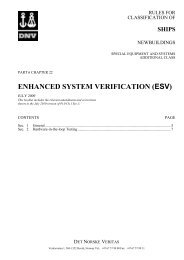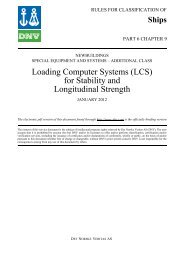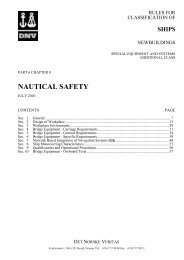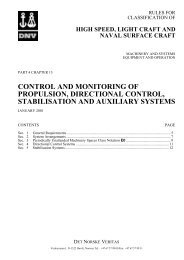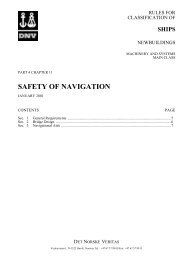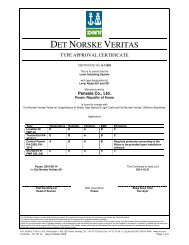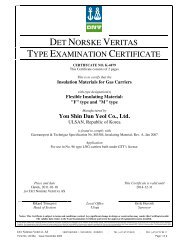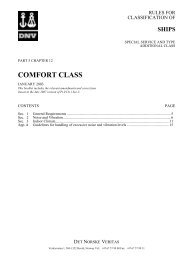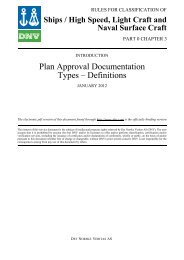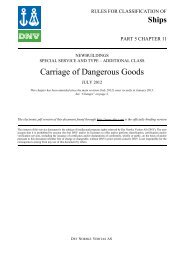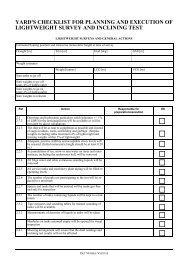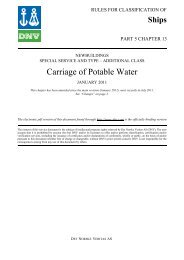Ship rules Pt.5 Ch.11 - Carriage of Dangerous Goods - DNV Exchange
Ship rules Pt.5 Ch.11 - Carriage of Dangerous Goods - DNV Exchange
Ship rules Pt.5 Ch.11 - Carriage of Dangerous Goods - DNV Exchange
You also want an ePaper? Increase the reach of your titles
YUMPU automatically turns print PDFs into web optimized ePapers that Google loves.
DET NORSKE VERITAS AS<br />
Rules for <strong>Ship</strong>s, July 2012<br />
<strong>Pt.5</strong> <strong>Ch.11</strong> Sec.2 – Page 9<br />
Ref. Table 2 in the Annex to MSC/Circ.1146: Solid bulk cargoes categorized into Group B in the IMSBC Code for<br />
which a fixed gas fire-extinguishing system is ineffective and for which a fire-extinguishing system giving equivalent<br />
protection shall be available. Acc. to the Annex to MSC/Circ.1120 water supplies, as defined in B102, are considered<br />
as an acceptable system giving equivalent protection. Another system giving equivalent protection is a fixed water<br />
spray system giving at least 5 l/m 2 pr. min. evenly dispersed.<br />
---e-n-d---<strong>of</strong>---G-u-i-d-a-n-c-e---n-o-t-e---<br />
202 Each open ro-ro cargo space having a deck above it and each space deemed to be a closed ro-ro cargo<br />
space not capable <strong>of</strong> being sealed, shall be fitted with an approved fixed pressure water-spray system for<br />
manual operation which is to protect all parts <strong>of</strong> any deck and vehicle platform in such space. The capacity <strong>of</strong><br />
the system shall be sufficiently for providing at least 5 litres/m2 /min. <strong>of</strong> the horizontal area <strong>of</strong> decks and<br />
platforms. The use <strong>of</strong> any other fixed fire-extinguishing system that has been shown by full-scale test to be no<br />
less effective, may be permitted.<br />
(SOLAS Reg. II-2/19.3.9)<br />
B 300 Electrical installations<br />
301 Electrical equipment and wiring shall not be fitted in hazardous areas and in areas where explosives are<br />
stored unless it is essential for the safety and operation <strong>of</strong> the ship.<br />
(IEC 60092-506, 5.1)<br />
302 The hazardous area shall be categorised in accordance with IEC 60092-506 Annex B, see Table B1:<br />
Guidance note:<br />
The spaces are categorised as hazardous only when dangerous goods are carried.<br />
Table B1 Cargo classes - description <strong>of</strong> areas<br />
Cargo classes Typical example Description<br />
Bulk: Classes 4.1, 4.2,<br />
— Closed cargo spaces<br />
4.3 and 9, and MHB<br />
Packaged: Classes 1.1-<br />
1.6 except l.4S, 2.1,<br />
3 w. FP ≤ 23° C,<br />
6.1 w. FP ≤ 23° C,<br />
8 w. FP ≤ 23° C and 9<br />
evolving flammable<br />
vapour.<br />
— Permanently fixed magazines<br />
Bulk: Classes 4.1, 4.2,<br />
— Pipes having open ends (e.g.<br />
4.3 and 9, and MHB<br />
ventilation and bilge pipes, etc.) in a<br />
Packaged: Classes 1.1-<br />
1.6 except l.4S, 2.1,<br />
3 w. FP ≤ 23° C,<br />
6.1 w. FP ≤ 23° C and<br />
8 w. FP ≤ 23° C and 9<br />
evolving flammable<br />
vapour.<br />
hazardous area.<br />
Bulk: Classes 4.3<br />
— Enclosed or semi-enclosed space<br />
Packaged: Classes 2.1,<br />
with direct opening to closed cargo<br />
3 w. FP ≤ 23° C,<br />
6.1 w. FP ≤ 23° C,<br />
8 w. FP ≤ 23° C and 9<br />
evolving flammable<br />
vapour.<br />
space<br />
Bulk: Classes 4.3<br />
— Enclosed or semi-enclosed space<br />
Packaged: Classes 2.1,<br />
with direct opening to closed cargo<br />
3 w. FP ≤ 23° C,<br />
space with gastight door and natural<br />
6.1 w. FP ≤ 23° C,<br />
8 w. FP ≤ 23° C and 9<br />
evolving flammable<br />
vapour.<br />
ventilation.<br />
— Space protected by overpressure in<br />
accordance with 303.



